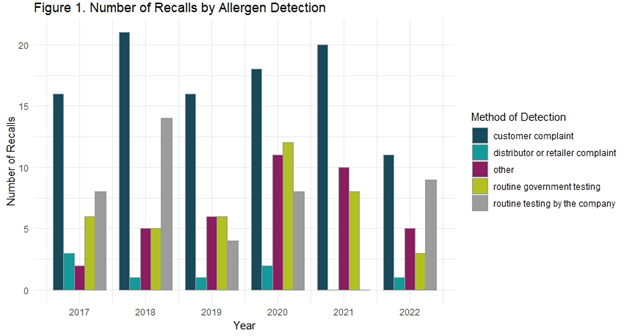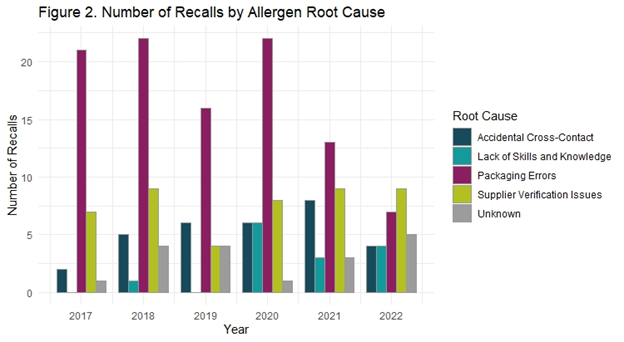Page last updated April 20223FSANZ data on Australian food recalls helps identify key issues, track trends and develop prevention strategies. Undeclared allergens is the most common reason for food recalls year-on-year. Below is an analysis of food recalls due to undeclared allergens since 2017. This information expands on analysis of
food recall statistics for the last 10 years. These statistics are updated annually.
Table 1: Undeclared allergen food recalls 2017-2022
| 2017 | 2018 | 2019 | 2020 | 2021 |
2022
|
|
| Number of undeclared allergen recalls | 35 | 46 | 33 |
51 | 38 | 29 |
| % of total recalls for that year | 50% |
46% |
38% |
47% |
48% |
39% |
Problem detection
Problem detection information is collected when FSANZ coordinates a recall. It is separated into five categories listed at Table 2. The 'other' category is used for detection that does not fit within the four categories (including unreported).
Table 2: Problem detection for undeclared allergen recalls 2017-2022
| Detection |
2017 | 2018 | 2019 | 2020 | 2021 |
2022
|
Total |
| Customer complaint | 16 | 21 | 16 | 18 | 20 | 11 |
102 |
| Distributor or retailer complaint | 3 | 1 | 1 | 2 | 0 | 1 |
8 |
| Other |
2 |
5 |
6 |
11 |
10 |
5 |
38 |
| Routine government testing | 6 |
5 | 6 | 12 | 8 | 3 |
40 |
| Routine testing by the company | 8 |
14 | 4 | 8 | 0 | 9 |
43 |

As shown in Figure 1, customer complaint is the most common method of detecting the need to recall food due to undeclared allergens.
Root cause
FSANZ uses information provided at the time of recall and in the post recall report to determine the root cause of undeclared allergen recalls. FSANZ has reviewed allergen-related recalls and identified 5 root causes of undeclared allergens:
- product packed in the wrong packaging
- front of pack dairy free claim instead of a gluten free claim
- incorrect ingredient list.
Accidental cross contamination either of a raw ingredient or during the final production process.
Lack of skills and knowledge to fulfil labelling requirements, for example:
- pasta was declared as an ingredient, but wheat was not
- ingredients were reformulated however labelling did not reflect the new ingredients
- ingredients were not fully-translated into English from the original language.
Supplier verification issues, for example a raw ingredient contained an allergen but this information was not passed on to the manufacturer.
Unknown, for example:
- the food business was not able to determine what caused the issue at the time of recall, or when submitting their post recall report
- the food business did not provide enough information to FSANZ to identify root cause at the time of recall, or in their post recall report.
Table 3: Root cause for undeclared allergens food recalls mid 2017-2022
| Root cause |
2017 | 2018 | 2019 | 2020 | 2021 |
2022
|
Total |
| Accidental cross-contact |
2 |
5 |
6 |
6 |
8 |
4 |
31 |
| Lack of skills and knowledge |
0 |
1 |
0 |
6 |
3 |
4 |
14 |
| Packaging errors | 21 |
22 |
16 |
22 |
13 |
7 |
101 |
| Supplier verification issues | 7 |
9 |
4 |
8 |
9 |
9 |
46 |
| Unknown | 1 |
4 |
4 |
1 |
3 |
5 |
18 |
| Total | 31 | 41 | 30 | 43 | 36 | 29 |
210 |

